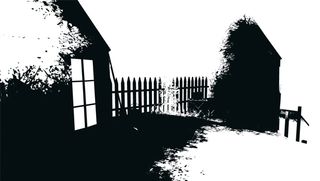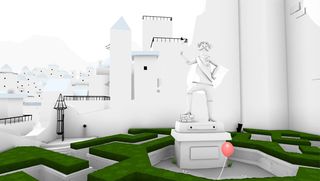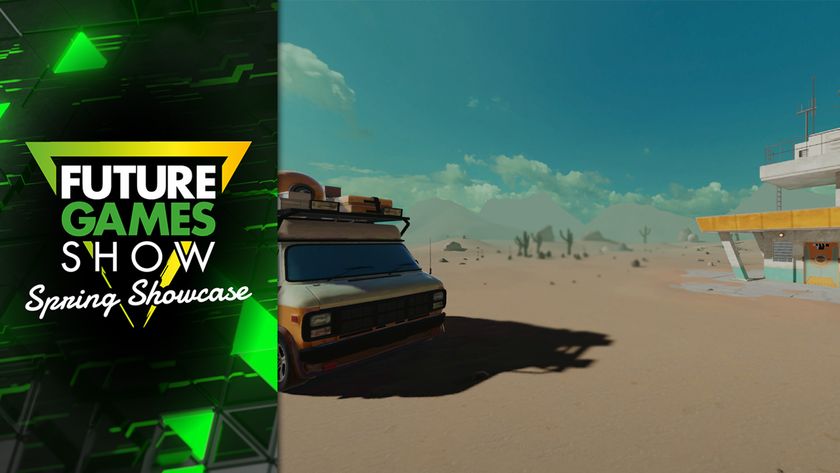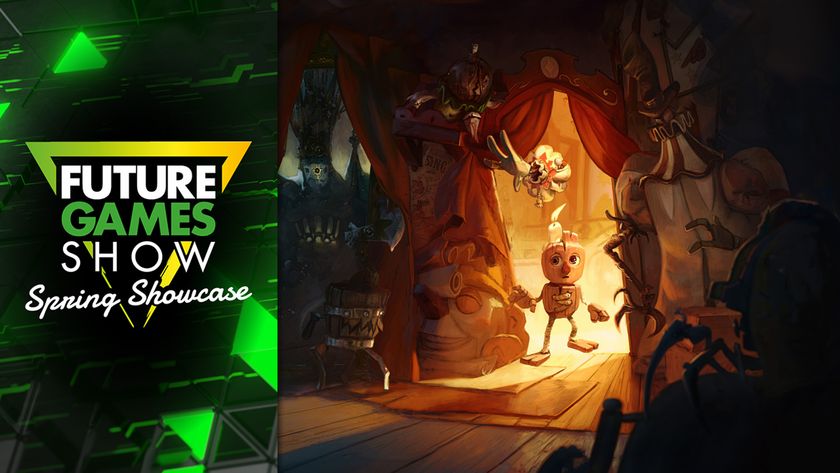The Unfinished Swan - a postmortem interview with creator Ian Dallas
The inspirations and creative process behind this indie gem

Bringing the abstract to life
With the release of The Unfinished Swan earlier this week, PS3 gamers now have a chance to experience the story of Monroe, an orphan who stumbles into a magical world. We highly recommend you check out this unconventional adventure (which we praised in our review)--and, because we found its concept so darn interesting, we got in touch with Ian Dallas, the game's creator, to talk about the game.

GamesRadar: What inspired the game's design?
Ian Dallas: The game began as a graduate student project. I was in the USC game design program and every week I was supposed to come up with a new interactive prototype. At the time I was really interested in how people move through space and one week I made this white room where you had to throw paint to see what was around you. What I liked most about the prototype was the sense of curiosity it gave you as a player, looking out into a blank landscape where anything was possible. So I set out to try and make an entire game around that feeling of awe and wonder that was there in the original prototype.

GR: What were the biggest hurdles you had to overcome during development?
ID: Finding elegant ways of guiding players was our biggest challenge in terms of game design. We wanted the player to feel like this was a world of infinite possibilities so in the beginning we designed spaces that gave players a lot of freedom in which way they could go. The result was that players spent a lot of time wandering around and got frustrated, then bored. By constraining players a bit more and by giving them clearer goals we found it actually encouraged them to wander off the main path to poke around a bit, since they felt confident they could find their way back later.
For the artists and programmers I think the biggest challenge was the wide range of art styles and game mechanics that we introduce. Most games focus on a few key styles and mechanics, but since this is a game about discovery we wanted to keep changing things up often enough that players were always curious about what might be around the corner.

GR: The Unfinished Swan lets players discover its world at their own pace. What were the challenges in designing a game around that while still providing enough enticement to keep players moving forward?
ID: One of the things we learned from the original white room prototype was that without having explicit goals most players would have fun throwing paintballs for between three to five minutes. After that they got bored. So what we tried to do was strike a balance of giving players a clear long-term goal (find the swan) and a pretty clear mid-term goal (e.g. maybe I should checkout those swan footprints in the middle of the pond) but a very undefined short-term goal (e.g. how do I get to the middle of the pond?).
I think players want to know if theyre headed in the right direction. Its like a compass, its a way of orienting themselves. The surprising part is that once they know which way is the correct path then theyre more inclined to wander off it and feel free to explore the world, which is what we wanted them to do in the first place. Its counter-intuitive but I think you have to give players a certain amount of structure in order for them to appreciate and enjoy the openness.

GR: As a game built around throwing balls of paint, were you worried about keeping players interested?
ID: Our goal was to show players something new every 60 seconds or so. Sometimes itd be something small, like a creature, and sometimes itd be a whole new mechanic. We watched a lot of playtests and as soon as we saw players were getting comfortable with a mechanic we tried to move on to something else. We wanted the game to be about discovering things not about becoming an expert in them.
We definitely had a wishlist of things that we wanted to see in the game that never made it in. At one point we were thinking about critters we called tribbles that would come munch on your vines but we scrapped them for a variety of very sound reasons. Other things, like the light-up ball you roll in the Nighttime chapter were happy accidents. We all shed a tear when had to cut box surfing from the game, which was pretty cool. You could draw a box, tip it over, then jump on top of it while it slid down the mountain and off a sweet jump.

GR: There are different variations of paint throughout the gamewere there other types that didnt make the cut?
ID: Using different colors of paint as different paint powers was something we wanted to avoid, even though we did end up with effectively three different powers. We wanted to push what we could do with a limited palette, and stay away from building a game about collecting and upgrading different kinds of paint. Something like Lightning paint was never in the cards, but the water you throw was at one point used to make a river--itd make puddles which were actually 10 feet deep and you could link them together.
We had a working prototype of that, but we never found a way to make it interesting enough. We had a sandbox where you could connect the puddles up to a current and itd turn a watermill, but then it was like, ok, now what? And we never found a good answer to that question so we cut it.

GR: Was the whole game originally designed around filling in a blank world and exploring it?
ID: I think even early on we felt like having an entire game that was all white was going to be too much. Itd be like having a cake that was all frosting. It just works better in moderation.
What we tried to do instead was to keep the feeling we had being in all white space, of not knowing what was around you and having to explore the world to discover it, but doing that in ways that didnt involve a white world and black paint.

GR: Did you have any inspirations for the story? We got an Alice in Wonderland vibe.
ID: Alice in Wonderland was definitely the single biggest inspiration for us. The broad strokes of our plot--child wanders off into fantastical kingdom in search of missing animal--was lifted pretty directly.
I think one of the things Alice in Wonderland does beautifully is taking a lot of scenes that are essentially random (or at least unanticipated) in terms of their geography and tone and stitches them together into something that feels very cohesive and logical. We were dealing with a similar challenge in our game so that was helpful to use as a guide. I think there actually is a through-line to both experiences, but its operating at a somewhat subconscious level (in Alice in Wonderland every scene is broadly about trying to understand and deal with nonsensical things while every area of The Unfinished Swan is loosely about seeing the world in new ways). The strong, simple through-line of child chasing animal is a great counterpoint to the less structured moment-to-moment experience.

GR: In terms of narrative, the fairy tale-like story of Monroe was great. Had there been other ideas you toyed around with instead?
ID: Once I knew that I wanted to make a game about evoking a sense of awe and wonder I went out looking for things that did a good job of that. Storybooks were the best models I could find so I thought a lot about why they worked so well and tried to apply that to the game. One of the reasons we chose to give the game a very overt storybook style was to remind players of what it felt like to be a child, to help put them in a good mindset for a game about curiosity and wonder.

GR: One thing we noticed right away was how instrumental the music was in providing context for a world you couldnt always see. Had this been a goal from the onset?
ID: The music was beautifully produced by our music supervisor Peter Scaturro and our composer Joel Corelitz along with a bunch of other fine folks on the Sony audio team. Peter and I talked about how we wanted players to feel at various points and then Peter and Joel did the rest. One of things that worked really well was to have areas with very minimal music, which helped create a sense of being alone--that is pretty tough to capture. And then we could bring the music back in at moments where we wanted to push the tone in a different direction.

GR: What was it like working with Sony? What did that relationship allow you to accomplish?
ID: Sony has been fantastic. I think we both had a very similar goal: making an experience players have never had before. As part of our contract they provided office space, equipment, and even technical advisors from the God of War team whod come by every week to offer suggestions on how to work with the PS3.
Having access to things like dedicated playtesting rooms, fully stocked kitchens, and in-house IT support isnt very indie, I guess, but it gave us a chance to focus all of our attention on one thing: making the best game we possibly could.

Ryan was once the Executive Editor of GamesRadar, before moving into the world of games development. He worked as a Brand Manager at EA, and then at Bethesda Softworks, before moving to 2K. He briefly went back to EA and is now the Director of Global Marketing Strategy at 2K.












